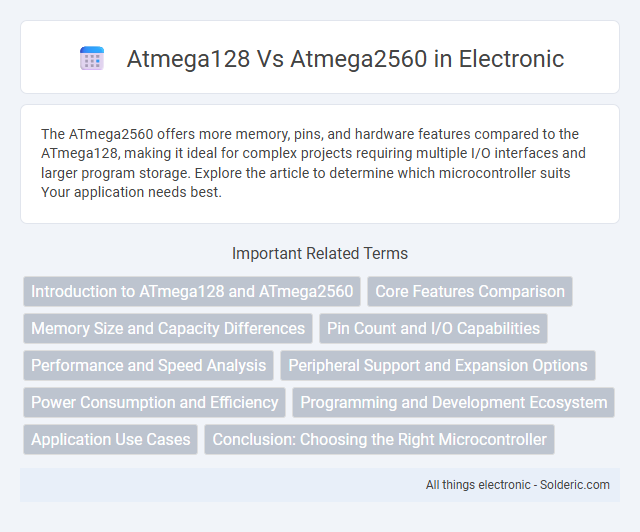The ATmega2560 offers more memory, pins, and hardware features compared to the ATmega128, making it ideal for complex projects requiring multiple I/O interfaces and larger program storage. Explore the article to determine which microcontroller suits Your application needs best.
Comparison Table
| Feature | ATmega128 | ATmega2560 |
|---|---|---|
| Microcontroller Type | 8-bit AVR | 8-bit AVR |
| Flash Memory | 128 KB | 256 KB |
| SRAM | 4 KB | 8 KB |
| EEPROM | 4 KB | 4 KB |
| CPU Speed | 16 MHz | 16 MHz |
| GPIO Pins | 53 | 86 |
| Timers | 3 timers (2x 8-bit, 1x 16-bit) | 6 timers (4x 16-bit, 2x 8-bit) |
| ADC Channels | 8 | 16 |
| USART Modules | 2 | 4 |
| SPI Interface | Yes | Yes |
| I2C (TWI) Interface | Yes | Yes |
| Operating Voltage | 4.5 - 5.5 V | 4.5 - 5.5 V |
| Package | 64-pin, 100-pin QFP/LQFP | 100-pin TQFP |
Introduction to ATmega128 and ATmega2560
The ATmega128 and ATmega2560 are popular microcontrollers from the AVR family, widely used in embedded systems and robotics. The ATmega128 features 128KB of flash memory, 4KB of SRAM, and 4KB of EEPROM, while the ATmega2560 offers double the flash memory at 256KB, 8KB of SRAM, and 4KB of EEPROM, providing enhanced performance and greater capacity for complex applications. Both microcontrollers support 8-bit architecture, multiple I/O ports, and advanced peripherals, making them suitable for various development projects and industrial applications.
Core Features Comparison
The Atmega128 features a 16 MHz AVR core with 128 KB of flash memory, 4 KB of SRAM, and 4 KB of EEPROM, making it suitable for mid-sized embedded applications. In contrast, the Atmega2560 offers a more powerful 16 MHz AVR core with double the flash memory at 256 KB, 8 KB of SRAM, and 4 KB of EEPROM, providing more resources for complex projects. Your choice depends on memory needs and I/O requirements, as the Atmega2560 also supports more peripherals and pins than the Atmega128.
Memory Size and Capacity Differences
The Atmega128 offers 128 KB of flash memory, while the Atmega2560 doubles this capacity with 256 KB, providing greater space for complex code and larger programs. RAM size also differs, with the Atmega128 featuring 4 KB and the Atmega2560 offering 8 KB, enhancing data handling and buffering capabilities. Your choice between these microcontrollers should consider the memory requirements of your application to ensure optimal performance and scalability.
Pin Count and I/O Capabilities
The Atmega128 features 53 programmable I/O pins, empowering moderate peripheral interfacing and control in embedded applications. In contrast, the Atmega2560 offers an expanded set of 86 programmable I/O pins, significantly enhancing hardware connectivity and flexibility for complex projects. This increased pin count in Atmega2560 translates to superior I/O capabilities, making it ideal for advanced microcontroller applications requiring extensive input/output management.
Performance and Speed Analysis
The ATmega2560 offers a higher clock speed of up to 16 MHz, matching the ATmega128, but provides enhanced performance through its larger memory and more extensive peripheral set, enabling more complex applications. With 256 KB of flash memory compared to the ATmega128's 128 KB, the ATmega2560 supports larger codebases and faster execution of memory-intensive tasks. Both MCUs use the same AVR architecture, but the ATmega2560's increased RAM and I/O pins contribute to improved multitasking and processing efficiency in demanding embedded systems.
Peripheral Support and Expansion Options
The ATmega2560 offers significantly more peripheral support and expansion options compared to the ATmega128, featuring 86 general-purpose I/O pins and multiple USART, SPI, and I2C interfaces. It includes four 16-bit Timer/Counters and an extended number of PWM channels, enabling more complex control applications. The increased memory and peripheral count make the ATmega2560 ideal for large-scale embedded systems requiring extensive I/O and communication capabilities.
Power Consumption and Efficiency
The ATmega128 operates at a lower power consumption with active mode current typically around 8 mA at 16 MHz, making it suitable for energy-sensitive applications. The ATmega2560, while offering higher memory capacity, generally consumes more power, approximately 10-12 mA at 16 MHz active mode. Both MCUs support various sleep modes that significantly reduce power draw, but the ATmega128's smaller memory and processing capabilities contribute to its efficiency in low-power environments.
Programming and Development Ecosystem
The ATmega128 and ATmega2560 both support AVR architecture with compatibility for standard development tools such as Atmel Studio and GCC, but the ATmega2560 offers enhanced flexibility with more I/O pins and increased memory size, benefiting complex applications. The ATmega2560's expanded 256KB flash memory and 8KB SRAM allow for larger, more sophisticated program storage and runtime operations compared to the ATmega128's 128KB flash and 4KB SRAM. Both microcontrollers integrate seamlessly with Arduino IDE, though the ATmega2560 is favored in advanced projects requiring extensive library support and resource management.
Application Use Cases
ATmega128 suits embedded systems requiring moderate memory and efficient performance, such as industrial automation, consumer electronics, and automotive diagnostics. ATmega2560 excels in complex projects demanding extensive I/O capabilities and higher memory capacity, making it ideal for 3D printers, robotics, and advanced data acquisition systems. Both microcontrollers support versatile applications, but ATmega2560's expanded resources enable more extensive multitasking and peripheral integration.
Conclusion: Choosing the Right Microcontroller
The ATmega2560 offers more memory with 256KB flash and 8KB SRAM compared to ATmega128's 128KB flash and 4KB SRAM, making it ideal for complex projects requiring extensive code and data storage. Its increased number of I/O pins, timers, and communication interfaces provides greater flexibility and scalability for advanced applications. Selecting the right microcontroller depends on project requirements, where ATmega128 suits simpler designs while ATmega2560 is optimal for large-scale, feature-rich developments.
atmega128 vs atmega2560 Infographic

 solderic.com
solderic.com